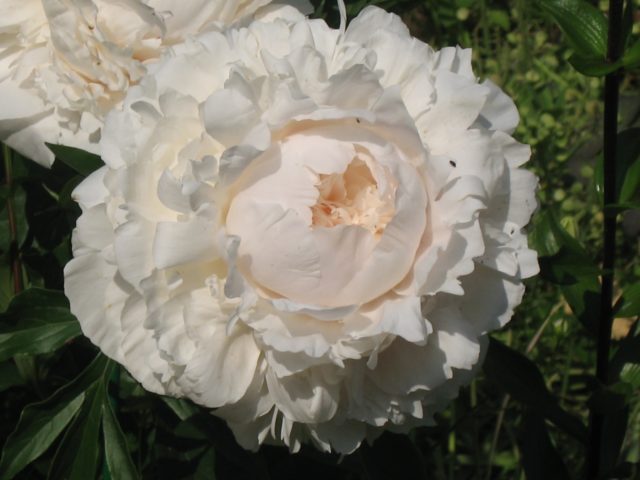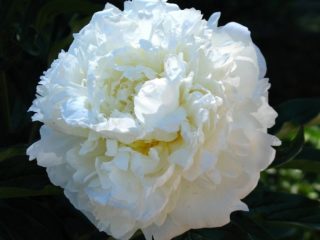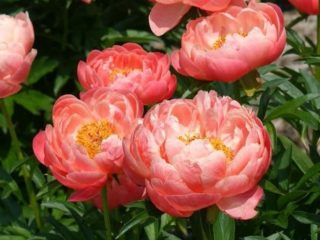Content
Peony Solange is a herbaceous large-flowered variety of medium-late flowering. Sun-loving, unpretentious plant with a compact bush, but falling apart during the budding period. Peony Solange was registered in 1907 in France.

The Solange variety has spherical, large flowers
Description of peony Solange
A bush of the Solange variety with a spreading crown and thick shoots grows up to 70-90 cm.The dark green trifoliate leaves are large, dissected, up to 20-30 cm long.
Oval-elongated leaf blades from above are shiny, with a pointed tip, reddish veins, like the stems. Thick leaves keep the decorative effect of the bush throughout the warm season. Although the stems of Solange peonies are powerful in appearance, they are not always stable. Under the weight of large flowers, they lean to the ground. Therefore, a bush of old French selection is always surrounded by a strong frame.
The rhizomes of the Solange variety are large, fusiform, covered with a brownish-brown skin on top. In the spring, shoots grow rapidly from the buds. The Solange variety is frost-resistant, tolerates temperatures up to -40 ° C, develops well in any regions of the middle climatic zone. For lush flowering, it requires enough watering and fertilizing. The Solange peony pleases with luxurious flowering in one place without transplanting for up to 20 years, then the bush is moved or completely changed the volume of the substrate in the same planting pit.
Flowering features
Spherical, densely double flowers of the Solange variety are very lush and voluminous, 16-20 cm in diameter. There are many light cream petals, and they create a magnificent rounded flower shape, similar to a huge air pompom. The middle of the Solange peony is invisible among the mass of petals, small, yellow. The lower petals are much larger than the central ones, the upper ones are gracefully concave. A fresh and rather strong aroma is felt near the Solange bush.
Solange's pinkish buds rarely bloom the following spring after an autumn planting. Flowering usually begins in the second year of growth, when the rhizomes take root and create flower buds. The medium-late variety Solange opens its buds at the end of the second decade of June, and in cooler regions - at the beginning of July. The peony blooms for 7-10 days, in good weather it does not lose its attractiveness for a long time.
For a luxurious flowering, the plant needs appropriate care:
- autumn and spring feeding;
- regular watering, especially in the budding phase;
- illuminated area, protected from sudden gusts of wind.
Application in design
Lush grassy peony Solange is a real decoration for the garden and any flower bed. Design solutions for the use of a luxurious milky-flowered variety are different:
- tapeworm in flower beds or in the center of the lawn;
- medium-sized element in the background of mixborders;
- a bright light accent against the background of dwarf coniferous shrubs or plants with crimson foliage;
- corner component of garden paths, spaces near the entrance;
- a curb for a paved area near the house or terrace;
- framing for a summer reservoir;
- back and side background for garden benches.
The dark green dense foliage of the Solange variety is decorative for a long time. White-creamy flowers go well with varieties of peonies of other colors, decorative deciduous and floral shrubs, low conifers. Peony Solange blooms during the blooming of roses, delphiniums, irises, lilies, daylilies and clematis. The varieties of these crops, similar in color or contrasting, go well together.The border near the luxurious bush of Solange peonies is planted with heuchera or annuals: petunia, lobelia, low species of irises blooming in spring, daffodils and other small bulbs that bloom in early June.

Solange petals with iridescent shades ranging from pale pink to creamy and crisp white
When choosing neighbors for a peony, you must be guided by the following rules:
- there must be a distance of at least 1 m between different bushes for good ventilation;
- always leave the area of the peony's trunk circle open for loosening.
Peony Solange is often used for cutting and creating bouquet arrangements, as they retain their splendor for a long time in water. The variety is not very suitable for tub culture. If grown, use containers of 20 liters, and the number of shoots is normalized, no more than 5-6 for a container.
Reproduction methods
It is most convenient to propagate Solange peonies by rhizomes. The variety has a powerful root system: the tubers are thick, dense. Therefore, it easily takes root even after planting in the spring. Experienced growers propagate the Solange peony by spring cuttings, cuttings of formed stems before flowering, or by dropping cuttings in early June. In most cases, spring peony transplantation is not recommended. The plant will develop a green mass, not a root system, which is important for the subsequent lush flowering.
Landing rules
The spectacular flower is bred mainly in the fall - from mid-August to mid-September. When choosing a site for a large-flowered peony, they adhere to the requirements:
- a place open to the sun most of the day and protected from strong winds;
- when planting near buildings, they retreat from the walls by 1 m;
- should not be placed in lowlands where melt or rainwater collects;
- the culture develops best of all on loams with a weakly acidic reaction.
Planting pits with a depth and diameter of 50 cm for several bushes of a variety with a spreading crown are dug at intervals of 1 m. Drainage is placed below, then a mixture of humus or compost with garden soil equally, 0.5 liters of wood ash and 60-80 g of superphosphate. Selected, healthy rhizomes, with buds and without traces of damage, are planted to a depth of 10 cm. They are covered with the remaining substrate, slightly compacted and watered. Usually, in the first year of planting, the plant does not bloom, the buds bloom in the second or third year. If you do not have time with the autumn planting, the peonies are planted in the spring. In the initial period of development, ensure that the seedlings receive sufficient watering and develop well.
Follow-up care
Young peony is watered abundantly, especially during periods of drought. The frequency of watering is 1-2 times a week, depending on weather conditions, 20-30 liters of water for an adult bush, in the south they arrange sprinkling in the evening. After watering, the soil is slightly loosened in the near-trunk circle, weeds are removed that interfere with nutrition and can become a source of disease and pest reproduction.
For luxurious flowering in the first year, fertilizing is carried out with complex potassium-phosphorus fertilizer only in the fall, at the end of August or at the beginning of September.
Adult bushes are fed three times per season:
- at the end of March or in April with ammonium nitrate or urea;
- in May with nitrogen-potassium preparations;
- after flowering, peonies are supported with complex fertilizers for flower shrubs.

In autumn, instead of potash fertilizers, wood ash is introduced
Preparing for winter
The bush of the large-flowered Solange variety is rationed. For a more lush flowering, only the first largest buds are left on the peduncle, all subsequent ones are cut off at the beginning of their formation.
After flowering, wilted buds are cut off. Broken stems and leaves are removed. At the same time, you cannot cut off all the stems early.Until autumn, the process of photosynthesis continues, with the help of which the rhizome accumulates the necessary substances to create replacement buds. All shoots are cut only before frost.
In the middle lane, only young peony seedlings are sheltered for the first two years. Having made water-charging irrigation at the end of September, the bush is spudded, covered with agrofibre or spruce branches on top. Adult bushes are only spud with compost or humus mixed with garden soil.
Pests and diseases
The Solange variety is not susceptible to gray rot, but it is possible to be affected by other fungi. Preventive spring spraying of the near-trunk circle with Bordeaux mixture or copper sulfate prevents diseases and the development of pests. In a viral leaf roll infection, the plants are removed from the site.
Peony flowers are annoyed by garden ants and bronze beetles, which feed on the juice of the buds and disfigure the petals. Manual collection is used against bronzes, and targeted preparations are used against ants.
Conclusion
Peony Solange is an exquisite decoration of any garden, frost-resistant and sun-loving variety, suitable for growing in areas of the middle lane. Only young bushes are sheltered for the winter. The right substrate and easy maintenance will ensure the plant grows well.








